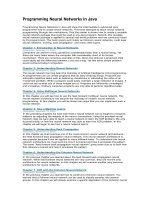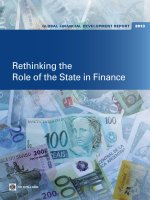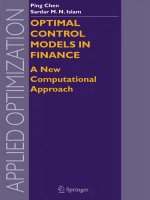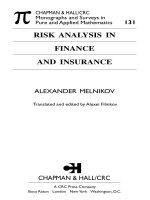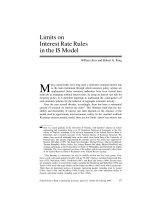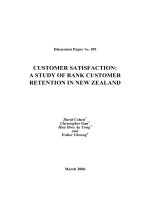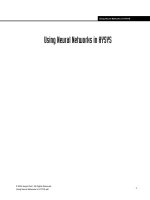Elsevier, Neural Networks In Finance 2005_7 pot
Bạn đang xem bản rút gọn của tài liệu. Xem và tải ngay bản đầy đủ của tài liệu tại đây (462.87 KB, 27 trang )
146 6. Times Series: Examples from Industry and Finance
aggregate and disaggregated market forecasting with traditional time series
as well as with pooled time-series cross-sectional methodologies, such as the
study by McCarthy (1996).
The structure of the automobile market (for new vehicles) is recursive.
Manufacturers evaluate and forecast the demand for the stock of automo-
biles, the number of retirements, and their market share. Adding a dose of
strategic planning, they decide how much to produce. These decisions occur
well before production and distribution take place. Manufacturers are pro-
viding a flow of capital goods to augment an existing stock. For their part,
consumers decide at the time of purchase, based on their income, price, and
utility requirements, what stock is optimal. To the extent that consumer
decisions to expand the stock of the asset coincide with or exceed the
amount of production by manufacturers, prices will adjust to revise the
optimal stock and clear the market. To the extent they fall short, the num-
ber of retirements of automobiles will increase and the price of new vehicles
will fall to clear the market. Chow (1960), Hess (1977), and McCarthy
(1996) show how forecasting the demand in the markets is a sufficient
proxy to modeling the optimal stock decision.
Both the general stability in the underlying market structure and the
recursive nature of producer versus consumer decision making have made
this market amenable to less complex estimation methods. Since research
suggests this is precisely the kind of market in which linear time-series
forecasting will perform rather well, it is a good place to test the usefulness
of the alternative of neural networks for forecasting.
1
6.1.1 The Data
We make use of quantity and price data for automobiles, as well as an
interest rate and a disposable income as aggregate variables. The quantity
variable represents the aggregate production of new vehicles, excluding
heavy trucks and machinery, obtained from the Bureau of Economic Anal-
ysis of the Department of Commerce. The price variable is an index
appearing in the Bureau of Labor Statistics. The interest rate argument
is the home mortgage rate available from the Board of Governors of the
U.S. Federal Reserve System, while the income argument is personal dis-
posable income, also obtained from the Bureau of Economic Analysis of
the Department of Commerce. Home mortgage rates were chosen as the
relevant interest rate following Hess (1977), who shows that consumers con-
sider housing and automobile decisions jointly. Personal disposable income
was generated from consumption and savings data. The consumption series
1
These points were made in a joint work with Gerald Nickelsburg. See McNelis and
Nickelsburg (2002).
6.1 Forecasting Production in the Automotive Industry 147
1992 1993 1994 1995 1996 1997 1998 1999 2000 2001
−0.05
0
0.05
1992 1993 1994 1995 1996 1997 1998 1999 2000 2001
−0.02
0
0.02
1992 1993 1994 1995 1996 1997 1998 1999 2000 2001
−0.1
0
0.1
1992 1993 1994 1995 1996 1997 1998 1999 2000 2001
−0.5
0
0.5
Rate of Growth of Automobile Production
Rate of Growth of Automotive Prices
Change in Mortgage Rates
Rate of Growth of Disposable Income
FIGURE 6.1. Automotive industry data
was the average over the quarter to reflect more accurately the permanent
income concept.
Figure 6.1 pictures the evolution of the four variables we use in this exam-
ple: annualized rates of change of the quantity and price indices obtained
from the U.S. automotive industry, as well as the corresponding annual
changes in the U.S. mortgage rates and the annualized rate of growth of
U.S. disposable income.
We note some interesting features of the data: there has been no sharp
rise in the rate of growth of prices since the mid-90s, while the peak year
for automobile production growth took place between 1999 and 2000; and
disposable income growth has been generally positive, with the exception
of the recession at the end of the first Gulf War between 1992 and 1993.
Table 6.1 presents a statistical summary of these data.
We see that for the decade as a whole, there has been about a 4.5%
annual growth in automobile production, whereas the price growth has
been slightly less than 1% and disposable income growth has been about
0.5%. We also do not see a strong contemporaneous correlation between the
variables. In fact, there are two “wrong” signs: a negative contemporaneous
148 6. Times Series: Examples from Industry and Finance
TABLE 6.1. Summary of Automotive Industry Data
Annualized Growth Rates: 1992–2001
Quantity Price Mortgage Rates Disposable Income
Mean 0.0450 0.0077 −0.0012 0.0050
Std. Dev. 0.1032 0.0188 0.0092 0.0335
Correlation Matrix
Quantity Price Mortgage Rates Disposable Income
Quantity 1.0000
Price 0.2847 1.0000
Mortgage Rates 0.1248 0.1646 1.0000 0.2142
Disp. Income −0.1703 −0.3304 0.2142 1.0000
correlation between disposable income growth and quantity growth, and a
positive contemporaneous correlation between changes in mortgage rates
and quantity growth.
6.1.2 Models of Quantity Adjustment
We use three models: a linear model, a smooth-transition regime switching
model, and a neural network smooth-transition regime switching model
(discussed in Section 2.5). We are working with monthly data. We are
interested in the year-to-year changes in these data. When forecasting,
we are interested in the annual or twelve-month forecast of the quantity
of automobiles produced because investors are typically interested in the
behavior of a sector over a longer horizon than one month or one quarter.
Given the nature of lags in investment and time-to-build considerations,
production over the next few months will have little to do with decisions
made at time t.
Letting Q
t
represent the quantity of automobiles produced at time t,we
forecast the following variable:
∆
h
q
t+h
= q
t+h
− q
t
(6.1)
q
t
= ln(Q
t
) (6.2)
where h = 12, for an annualized forecast with monthly data.
The dependent variable ∆q
t+h
depends on the following set of current
variables x
t
x
t
=[∆
12
q
t
, ∆
12
p
t
, ∆
12
r
t
, ∆
12
y
t
] (6.3)
6.1 Forecasting Production in the Automotive Industry 149
∆
12
p
t
= ln(P
t
) −ln(P
t−12
) (6.4)
∆
12
r
t
= ln(R
t
) −ln(R
t−12
) (6.5)
∆
12
y
t
= ln(Y
t
) −ln(Y
t−12
) (6.6)
where P
t
,R
t
, and Y
t
signify the price index, the gross mortgage rate, and
disposable income at time t. Although we can add further lags for ∆q
t
,
we keep the set of regressions limited to the 12-month backward-looking
horizon. The current value of ∆q
t
looks back over 12 months while the
dependent variable looks forward over 12 months. We consider this a suffi-
ciently ample lag structure. We also wish to avoid the problem of searching
for different optimal lag structures for the three different models.
The linear model has the following specification:
∆q
t+h
= αx
t
+ η
t
(6.7)
η
t
=
t
+ γ(L)
t−1
(6.8)
t
∼ N (0,σ
2
) (6.9)
The disturbance term η
t
consists of a current period white-noise shock
t
in addition to eleven lagged values of this shock, weighted by the vector
γ. We explicitly model serial dependence as a moving average process since
it is well known that whenever the forecast horizon exceeds the sampling
interval, temporal dependence is induced in the disturbance term.
We compare this model with the smooth-transition regime switch-
ing (STRS) model and then with the neural network smooth-transition
regime switching (NNSTRS) model. The STRS model has the following
specification:
∆q
t+h
=Ψ
t
α
1
x
t
+(1− Ψ
t
)α
2
x
t
+ η
t
(6.10)
Ψ
t
=Ψ(θ · ∆y
t
− c) (6.11)
=1/[1 + exp(θ ·∆y
t
− c)] (6.12)
η
t
=
t
+ γ(L)
t−1
(6.13)
t
∼ N (0,σ
2
) (6.14)
where Ψ
t
is a logistic or logsigmoid function of the rate of growth of dis-
posable income, ∆y
t
, as well as the threshold parameter c and smoothness
parameter θ. For simplicity, we set c = 0, thus specifying two regimes, one
when disposable income is growing and the other when it is shrinking.
150 6. Times Series: Examples from Industry and Finance
The NNSTRS model has the following form:
∆q
t+h
= αx
t
+ β[Ψ
t
G(x
t
; α
1
)+(1− Ψ
t
)H(x
t
; α
2
)] + η
t
(6.15)
Ψ
t
=Ψ(θ · ∆y
t
− c) (6.16)
=1/[1 + exp(θ ·∆y
t
− c)] (6.17)
G(x
t
; α
1
)=1/[1 + exp(−α
1
x
t
)] (6.18)
H(x
t
; α
2
)=1/[1 + exp(−α
2
x
t
)] (6.19)
η
t
=
t
+ γ(L)
t−1
(6.20)
t
∼ N (0,σ
2
) (6.21)
In the NNSTRS model, Ψ
t
appears again as the transition function.
The functions G(x
t
; α
1
) and H(x
t
; α
2
) are logsigmoid transformations of
the exogenous variables x
t
, weighted by parameter vector α
1
in regime
G and by vector α
2
in regime H. We note that the NNSTRS model has
a direct linear component in which the exogenous variables are weighted
by parameter vector α, and a nonlinear component, given by time-varying
combinations of the two neurons, weighted by the parameter β.
The linear model is the simplest model, and the NNSTRS model is the
most complex. We see that the NNSTRS nests the linear model. If the
nonlinear regime switching effects are not significant, the parameter β =0,
so that it reduces to the linear model. The STRS model is almost linear,
in the sense that the only nonlinear component is the logistic smooth-
transition component Ψ
t
. However, the STRS model nests the linear model
only in a very special sense. With θ = c =0,Ψ
t
= .5 for all t, so that the
dependent variable is a linear combination of two linear models and thus a
linear model. However, the NNSTRS does not nest the STRS model.
We estimate these three models by maximum likelihood methods. The
linear model and the STRS models are rather straightforward to estimate.
However, for the NNSTRS model the parameter set is larger. For this
reason we make use of the hybrid evolutionary search (genetic algorithm)
method and quasi-Newton gradient-descent methods. We then evaluate the
relative performance of the three models by in-sample diagnostic checks,
out-of-sample forecast accuracy, and the broader meaning and significance
of the results.
6.1.3 In-Sample Performance
We first estimate the model for the whole sample period and assess the per-
formance of the three models. Figure 6.2 pictures the errors of the models.
The smooth lines represent the linear model, the dashed are for the STRS
6.1 Forecasting Production in the Automotive Industry 151
1994 1995 1996 1997 1998 1999 2000 2001 2002
−0.3
−0.25
−0.2
−0.15
−0.1
−0.05
0
0.05
0.1
0.15
0.2
Linear
STRS
NNSTRS
FIGURE 6.2. In-sample performance: rate of growth of automobile production
model, and the dotted curves are for the NNSTRS model. We see that the
errors of the linear model are the largest, but they all are highly correlated
with each other.
Table 6.2 summarizes the overall in-sample performance of the three
models. We see that the NNSTRS model does not dominate the other
STRS on the basis of the Hannan-Quinn selection criterion. For all three
models we cannot reject serial independence, both in the residuals and
in the squared residuals. Furthermore, the diagnostics on neglected non-
linearity are weakest on the linear model, but not by much, relative to
the nonlinear models. All three models reject normality in the regression
residuals.
6.1.4 Out-of-Sample Performance
We divided the sample in half and re-estimated the model in a recursive
fashion for the last 53 observations. The real-time forecast errors appear
in Figure 6.3. Again, the solid curves are for the linear errors, the dashed
curves for the STRS model and the dotted curves are for the NNSTRS
model. We see, for the most part, the error paths are highly correlated.
152 6. Times Series: Examples from Industry and Finance
TABLE 6.2. In-sample Diagnostics of Alternative Models (Sample: 1992–2002,
Monthly Data)
Diagnostics Models
Linear STRS NNRS
SSE 0.615 0.553 0.502
RSQ 0.528 0.612 0.645
HQIF −25.342 −22.714 −32.989
LB* 0.922 0.958 0.917
ML* 0.532 0.553 0.715
JB* 0.088 0.008 0.000
EN* 0.099 0.256 0.431
BDS* 0.045 0.052 0.051
LWG 0 0 0
*: prob value
NOTE:
SSE: Sum of squared errors
RSQ: R-squared
HIQF: Hannan-Quinn information criterion
LB: Ljung-Box Q statistic on residuals
ML: McLeod-Li Q statistic on squared residuals
JB: Jarque-Bera statistic on normality of residuals
EN: Engle-Ng test of symmetry of residuals
BDS:Brock-Deckert-Scheinkman test of nonlinearity
LWG: Lee-White-Granger test of nonlinearity
Table 6.3 summarizes the out-of-sample forecasting statistics of the three
models. The root mean squared error statistics show the STRS model is
the best, while the success ratio for correct sign prediction shows that the
NNSTRS model is the winner. However, the differences between the two
alternatives to the linear model are not very significant.
Table 6.3 has three sets of Diebold-Mariano statistics which compare,
pair-wise, the three models against one another. Not surprisingly, given the
previous information, the STRS and the NNSTRS errors are significantly
better than the linear model, but they are not significantly different from
each other.
6.1.5 Interpretation of Results
What do the models tell us in terms of economic understanding of the deter-
minants of automotive production? To better understand the message of
the models, we calculated the partial derivatives based on three states: the
beginning of the sample, the mid-point, and the final observation. We also
used the bootstrapping method to determine the statistical significance of
these estimates.
6.1 Forecasting Production in the Automotive Industry 153
1997 1997.5 1998 1998.5 1999 1999.5 2000 2000.5 2001 2001.5 2002
−0.5
−0.4
−0.3
−0.2
−0.1
0
0.1
0.2
0.3
0.4
Linear
STRS
NNSTRS
FIGURE 6.3.
TABLE 6.3. Out-of-Sample Forecasting Accuracy
Diagnostics Models
Linear STRS NNSTRS
RMSQ 0.180 0.122 0.130
SR 0.491 0.679 0.698
Diebold- Linear vs. Linear vs. STRS vs.
Mariano Test STRS NNSTRS NNSTRS
DM-1* 0.000 0.000 0.941
DM-2* 0.000 0.002 0.899
DM-3* 0.000 0.005 0.874
DM-4* 0.000 0.009 0.857
DM-5* 0.000 0.013 0.853
*: prob value
RMSQ: Root mean squared error
SR: Success ratio on sign correct sign predictions
DM: Diebold-Mariano Test
(correction for autocorrelation, lags 1-5)
154 6. Times Series: Examples from Industry and Finance
TABLE 6.4. Partial Derivatives of NNSTRS Model
Period Arguments
Production Price Interest Income
Mean 0.143 0.089 −0.450 0.249
1992 0.140 0.090 −0.458 0.249
1996 0.137 0.091 −0.455 0.248
2001 0.144 0.089 −0.481 0.250
Period Statistical Significance of Estimates Arguments
Production Price Interest Income
Mean 0.981 0.571 0.000 0.015
1992 0.968 0.558 0.000 0.001
1996 0.956 0.573 0.000 0.008
2001 0.958 0.581 0.000 0.008
The results appear in Table 6.4 for the NNSTRS model. We see that
the partial derivatives of the mortgage rate and disposable income have
the expected correct sign values and are statistically significant (based
on bootstrapping) at the beginning, mid-point, and end-points of the
sample, as well as for the mean values of the regressors. However, the
partial derivatives of both the lagged production and the price are statis-
tically significant. The message of the NNSTRS model is that aggregate
macroeconomic variables are more important for predicting developments
in automobile production than are price or lagged production developments
within the industry itself.
The results from the STRS models are very similar, both in magnitude
and tests of significance. These results appear in Table 6.5.
Finally, what information can we glean from the behavior of the smooth
transition neurons in the two regime switching models? How do they behave
relative to changes in disposable income? Figure 6.4 pictures the behav-
ior of these three variables. We see that disposable income only becomes
negative at the mid-point of the sample but at several points it is close
to zero. The NNSTRS and STRS neurons give about equal weight to
the growth/recession states, but the NNSTRS neuron shows slightly more
volatility throughout the sample.
Given the superior performance of the STRS and NNSTRS models rela-
tive to the linear model, the information in Figure 6.4 indicates that most
of the nonlinearity in the automotive industry has not experienced major
switches in regimes. However, the neurons in both the STRS and NNSTRS
model appear to detect nonlinearities which aid in forecasting performance.
6.1 Forecasting Production in the Automotive Industry 155
TABLE 6.5. Partial Derivatives of STRS Model
Period Arguments
Production Price Interest Income
Mean 0.187 0.094 −0.448 0.296
1992 0.186 0.096 −0.449 0.291
1996 0.185 0.098 −0.450 0.286
2001 0.188 0.092 −0.448 0.299
Period Statistical Significance of Estimates Arguments
Production Price Interest Income
Mean 0.903 0.587 0.000 0.000
1992 0.905 0.575 0.000 0.000
1996 0.891 0.581 0.000 0.000
2001 0.893 0.589 0.000 0.000
1994 1995 1996 1997 1998 1999 2000 2001 2002
−0.04
−0.02
0
0.02
0.04
0.06
1994 1995 1996 1997 1998 1999 2000 2001 2002
0.44
0.46
0.48
0.5
0.52
0.54
0.56
Rate of Growth of Disposable Income
Transition Neurons
NNSTRS Model
STRS Model
FIGURE 6.4. Regime transitions in STRS and NNSTRS models
156 6. Times Series: Examples from Industry and Finance
6.2 Corporate Bonds: Which Factors Determine
the Spreads?
The default rates of high-risk corporate bonds and the evolution of the
spreads on the returns on these bonds, over ten-year government bond
yields, appear in Figure 6.5.
What is most interesting about the evolution of both of these variables is
the large upswing that took place at the time of the Gulf War recession in
1991, with the default rate appearing to lead the return spread. However,
after 1992, both of these variables appear to move in tandem, without any
clear lead or lag relation, with the spread variable showing slightly greater
volatility after 1998. One fact emerges: the spreads declined rapidly in the
early 90s, after the Gulf War recession, and started to increase in the late
1990s, after the onset of the Asian crisis in late 1997. The same is true of
the default rates.
What is the cause of the decline in the spreads and the subsequent
upswing of this variable? The process of financial market development may
lead to increased willingness to take risk, as lenders attempt to achieve
1986 1988 1990 1992 1994 1996 1998 2000 2002
0
0.02
0.04
0.06
0.08
0.1
0.12
0.14
0.16
0.18
Spreads
Default Rates
FIGURE 6.5. Corporate bond spreads and default rates
6.2 Corporate Bonds: Which Factors Determine the Spreads? 157
gains by broader portfolio diversification, which could explain a gradual
decline, as lenders become less risk averse. Another factor may be the
spillover effects from increases or decreases in the share market, as well
as increased optimism or pessimism from the rate of growth of industrial
production or from changes in confidence in the economy. These latter two
variables represent business climate effects.
Collin-Dufresne, Goldstein, and Martin (2000) argue against macroeco-
nomic determinants of credit spread changes in the U.S. corporate bond
market. Their results suggest that the “corporate bond market is a seg-
mented market driven by corporate bond specific supply/demand shocks”
[Collin-Dufresne, Goldstein, and Martin (2000), p. 2]. In their view, the
corporate default rates, representing “bond specific shocks,” should be the
major determinant of changes in spreads. They do find, however, that share
market returns are negative and statistically significant determinants of
the spreads. Like many previous studies, their analysis is based on linear
regression methods.
6.2.1 The Data
We are interested in determining how these spreads respond to their own
and each other’s lagged values, to bond specific shocks such as default rates,
as well as to key macroeconomic variables often taken as leading indicators
of aggregate economic activity or the business climate: the real exchange
rate, the index of industrial production (IIP), the National Association of
Product Manufacturers’ Index (NAPM), and the Morgan Stanley Capital
International Index of the U.S. Share Market (MSCI). All of these variables,
presented as annualized rates of change, appear in Figure 6.6.
Table 6.6 contains a statistical summary of these data. As in the previous
example, we transform the spreads and default rates as annualized changes.
We see in this table that over the 15-year period, 1987–2002, the average
annualized change in the spread and the default rate is not very much.
However, the volatility of the default rate is about three times higher. Of
the macroeconomic and business climate indicators, we see that the largest
growth, by far, took place in the MSCI index during this period of time. It
also has the highest volatility.
The correlation matrix in Table 6.6 shows that the spreads are most
highly negatively correlated with the NAPM index and most highly posi-
tively correlated with the default rate. In turn, the default rate is negatively
correlated with changes in the index of industrial production (IIP).
6.2.2 A Model for the Adjustment of Spreads
We again use three models: a linear model, a smooth-transition regime
switching model, and a neural network smooth-transition regime switching
158 6. Times Series: Examples from Industry and Finance
1988 1990 1992 1994 1996 1998 2000 2002
−0.2
0
0.2
1988 1990 1992 1994 1996 1998 2000 2002
−0.5
0
0.5
1988 1990 1992 1994 1996 1998 2000 2002
−0.5
0
0.5
1988 1990 1992 1994 1996 1998 2000 2002
−0.1
0
0.1
NAPM Index
Real Exchange Rate
MSCI Share Market Index
Index of Industrial Production
FIGURE 6.6. Annualized rates of change of macroeconomic indicators
TABLE 6.6. Annualized Changes of Financial Sector Indicators, 1987–2002
Spread Default Rate Real. Ex. Rate NAPM Index MSCI Index IIP
Mean 0.0021 0.0007 0.0129 −0.0181 0.1012 0.0288
Std. Dev. 0.0175 0.0363 0.0506 0.1334 0.1466 0.0317
Correlation Matrix
Spread Default Rates Real. Ex. Rate NAPM Index MSCI Index IIP
Spread 1
Default Rate 0.3721 1
Real. Ex. Rate 0.1221 0.0286 1
NAPM Index −0.6502 −0.2335 −0.0277 1
MSCI Index −0.0838 0.0067 0.2427 0.1334 1
IIP −0.1444 −0.4521 −0.1181 0.3287 0.4258 1
model (discussed in Section 2.5). Again we are working with monthly data,
and we are interested in the year-on-year changes in these data. When
forecasting the spread, financial market participants are usually interested
in one-month or even shorter horizons.
6.2 Corporate Bonds: Which Factors Determine the Spreads? 159
Letting s
t
represent the spread between corporate and U.S. government
bonds at time t, we forecast the following variable:
∆s
t+h
= s
t+1
− s
t
(6.22)
where h = 1 for a one-period forecast with monthly data.
The dependent variable ∆s
t+h
depends on the following set of current
variables x
t
x
t
=[∆
12
dr
t
, ∆s
t
, ∆
12
rex
t
, ∆
12
iip
t
, ∆
12
msci
t
, ∆
12
napm
t
] (6.23)
∆dr
t
= dr
t
− dr
t−1
(6.24)
∆
12
rex
t
= ln(REX
t
) −ln(REX
t−12
) (6.25)
∆
12
iip
t
= ln(IIP
t
) −ln(IIP
t−12
) (6.26)
∆
12
msci
t
= ln(MSCI
t
) −ln(MSCI
t−12
) (6.27)
∆
12
iip
t
= ln(NAPM
t
) −ln(NPAM
t−12
) (6.28)
where ∆
12
dr
t
, ∆s
t
, ∆
12
rex
t
, ∆
12
iip
t
, ∆
12
msci
t
, and ∆
12
napm
t
signify the
currently observed changes in the default rate, the spreads, the index of
industrial production, the MSCI stock index, and the NAPM index at time
t. Since we work with monthly data, we use 12-month changes for the main
macroeconomic indicators to smooth out seasonal factors.
The linear model has the following specification:
∆q
t+h
= αx
t
+ η
t
(6.29)
η
t
=
t
+ γ(L)
t−1
(6.30)
t
∼ N (0,σ
2
) (6.31)
The disturbance term η
t
consists of a current period white-noise shock
t
in addition to eleven lagged values of this shock, weighted by the vector
γ. We explicitly model serial dependence as a moving average process as in
the previous case.
We compare this model with the smooth-transition regime switch-
ing (STRS) model and then with the neural network smooth-transition
regime switching (NNSTRS) model. The STRS model has the following
specification:
∆q
t+h
=Ψ
t
α
1
x
t
+(1− Ψ
t
)α
2
x
t
+ η
t
(6.32)
160 6. Times Series: Examples from Industry and Finance
Ψ
t
=Ψ(θ · ∆y
t
− c) (6.33)
=1/[1 + exp(θ ·∆y
t
− c)] (6.34)
η
t
=
t
+ γ(L)
t−1
(6.35)
t
∼ N (0,σ
2
) (6.36)
where Ψ
t
is a logistic or logsigmoid function of the rate of growth of dis-
posable income, ∆y
t
, as well as the threshold parameter c and smoothness
parameter θ. For simplicity, we set c = 0, thus specifying two regimes, one
when disposable income is growing and the other when it is shrinking.
The NNSTRS model has the following form:
∆q
t+h
= αx
t
+ β[Ψ
t
G(x
t
; α
1
)+(1− Ψ
t
)H(x
t
; α
2
)] + η
t
(6.37)
Ψ
t
=Ψ(θ · ∆y
t
− c) (6.38)
=1/[1 + exp(θ ·∆y
t
− c)] (6.39)
G(x
t
; α
1
)=1/[1 + exp(−α
1
x
t
)] (6.40)
H(x
t
; α
2
)=1/[1 + exp(−α
2
x
t
)] (6.41)
η
t
=
t
+ γ(L)
t−1
(6.42)
t
∼ N (0,σ
2
) (6.43)
6.2.3 In-Sample Performance
Figure 6.7 pictures the in-sample performance of the three models. We
see that the linear predictions are clear outliers with respect to the two
alternative models, especially at the time of the first Gulf War in late 1991.
The diagnostics appear in Table 6.7. We see a drastic improvement in
performance as we abandon the linear model in favor of either the STRS or
NNSTRS models. The Ljung-Box statistics indicate the presence of serial
correlation in the linear model while we cannot reject independence in the
alternatives. Both the Brock-Deckert-Scheinkman and Lee-White-Granger
tests indicate the presence of neglected nonlinearities in the residuals of the
linear model, but not in the residuals of the alternative models.
6.2.4 Out-of-Sample Performance
We again divided the sample in half and re-estimated the model in a
recursive fashion for the last 86 observations. The real-time forecast errors
appear in Figure 6.8. Again, the solid curves are for the linear errors, the
dashed curves for the STRS model, and the dotted curves for the NNSTRS
model. We see, for the most part, the error paths are highly correlated
6.2 Corporate Bonds: Which Factors Determine the Spreads? 161
1988 1990 1992 1994 1996 1998 2000 2002
−0.025
−0.02
−0.015
−0.01
−0.005
0
0.005
0.01
0.015
0.02
0.025
NNRS
Model
Linear Model
STRS Model
FIGURE 6.7. In-sample performance, change in bond spreads
with the two alternative models. However, large prediction error differences
emerge in the mid-1990s, late 1990s, and late 2001.
Table 6.8 summarizes the out-of-sample forecasting statistics of the three
models. The root mean squared error statistics show the STRS models as
the best, while the success ratio for correct sign predictions (for the pre-
dicted change in the corporate bond spreads) shows that the STRS model
is also the winner. However, the differences between the two alternatives
to the linear model are not very significant.
Table 6.8 has three sets of Diebold-Mariano statistics which compare,
pair-wise, the three models against one another. Again, the STRS and the
NNSTRS errors are significantly better than the linear model, but they are
not significantly different from each other.
6.2.5 Interpretation of Results
What do the models tell us in terms of economic understanding of the deter-
minants of automotive production? To better understand the message of
the models, we calculated the partial derivatives based on three states: the
beginning of the sample, the mid-point, and the final observation. We also
162 6. Times Series: Examples from Industry and Finance
TABLE 6.7. In-Sample Diagnostics of Alternative Models
(Sample: 1988–2002, Monthly Data)
Diagnostics Models
Linear STRS NNRS
SSE 0.009 0.003 0.003
RSQ 0.826 0.940 0.943
HQIF −763.655 −932.234 −937.395
LB* 0.000 0.980 0.948
ML* 0.276 0.792 0.875
JB* 0.138 0.000 0.000
EN* 0.005 0.712 0.769
BDS* 0.000 0.338 0.297
LWG 798 0 0
*: prob value
NOTE:
SSE: Sum of squared errors
RSQ: R-squared
HIQF: Hannan-Quinn Information Criterion
LB: Ljung-Box Q statistic on residuals
ML: McLeod-Li Q statistic on squared residuals
JB: Jarque-Bera statistic on normality of residuals
EN: Engle-Ng test of symmetry of residuals
BDS:Brock-Deckert-Scheinkman test of nonlinearity
LWG: Lee-White-Granger test of nonlinearity
used the bootstrapping method to determine the statistical significance of
these estimates.
The results appear in Table 6.9 for the NNSTRS model. We see signifi-
cant and relatively strong persistence in the spread, in that current spreads
have strong positive effects on the next period’s spreads. We see that the
effect of defaults is small and insignificant. The real exchange rate and
industrial production effects are both positive and significant, while the
effects of changes in the MSCI and NAPM indices are negative. In the
NNSTRS model, however, the MSCI effect is not significant.
The message of the NNSTRS model is that aggregate macroeconomic
variables are as important for predicting developments in spreads as
are market-specific developments, since both the real exchange rate and
changes in the NAPM, IIP, and lagged spreads play a significant role.
The results from the STRS models are very similar, both in magnitude
and tests of significance. The only difference appears in the significance of
the MSCI effect, which is significant in this model. This result is consistent
with the findings of Collin-Dufresne, Goldstein, and Martin (2000). These
results appear in Table 6.10.
6.2 Corporate Bonds: Which Factors Determine the Spreads? 163
1995 1996 1997 1998 1999 2000 2001 2002
−0.05
−0.04
−0.03
−0.02
−0.01
0
0.01
0.02
0.03
0.04
NNSTRS
Model
STRS Model
Linear Model
FIGURE 6.8. Forecasting performance of models
TABLE 6.8. Out-of-Sample Forecasting Accuracy
Diagnostics Models
Linear STRS NNSTRS
RMSQ 0.015 0.006 0.007
SR 0.733 0.917 0.905
Diebold-Mariano Linear vs. Linear vs. STRS vs.
Test STRS NNSTRS NNSTRS
DM-1* 0.000 0.000 0.942
DM-2* 0.000 0.000 0.943
DM-3* 0.000 0.000 0.939
DM-4* 0.001 0.001 0.936
DM-5* 0.002 0.002 0.897
*: prob value
RMSQ: Root mean squared error
SR: Success ratio on correct sign predictions
DM: Diebold-Mariano Test
(correction for autocorrelation, lags 1–5)
164 6. Times Series: Examples from Industry and Finance
TABLE 6.9. Partial Derivatives of NNSTRS Model
Period Arguments
Default Spread REXR IIP MSCI NAPM
Mean 0.033 0.771 0.063 0.134 −0.068 −0.066
1989 0.033 0.769 0.060 0.137 −0.065 −0.068
1996 0.030 0.777 0.071 0.128 −0.073 −0.061
2001 0.036 0.756 0.043 0.151 −0.053 −0.080
Statistical Significance of Estimates
Period Arguments
Default Spread REXR IIP MSCI NAPM
Mean 0.853 0.000 0.000 0.000 0.678 0.059
1989 0.844 0.000 0.000 0.000 0.688 0.055
1996 0.846 0.000 0.000 0.000 0.680 0.063
2001 0.848 0.000 0.000 0.000 0.684 0.055
TABLE 6.10. Partial Derivatives of STRS Model
Period Arguments
Default Spread REXR IIP MSCI NAPM
Mean 0.017 0.749 0.068 0.125 −0.139 −0.096
1989 0.010 0.752 0.070 0.128 −0.139 −0.098
1996 0.027 0.746 0.065 0.121 −0.138 −0.090
2001 −0.005 0.757 0.074 0.135 −0.140 −0.106
Statistical Significance of Estimates
Period Arguments
Default Spread REXR IIP MSCI NAPM
Mean 0.678 0.000 0.000 0.000 0.080 0.000
1989 0.699 0.000 0.000 0.000 0.040 0.000
1996 0.636 0.000 0.011 0.000 0.168 0.000
2001 0.693 0.000 0.000 0.000 0.057 0.000
Finally, we can ask what information we can glean from the behav-
ior of the smooth transition neurons in the two regime switching models.
How do they behave relative to changes in the IIP as the economy
switches from growth to recession? Figure 6.9 pictures the behavior of these
6.3 Conclusion 165
1988 1990 1992 1994 1996 1998 2000 2002
−0.1
−0.05
0
0.05
0.1
1988 1990 1992 1994 1996 1998 2000 2002
0.4
0.45
0.5
0.55
0.6
0.65
Rate of Growth of Index of Industrial Production
Smooth Transition Neurons
STRS Model
NNSTRS Model
FIGURE 6.9. Regime transitions in STRS and NNSTRS models
three variables. We see sharper changes in the IIP index than in dispos-
able income. The NNSTRS and STRS neurons give about equal weight to
the growth/recession states, but the NNSTRS neuron shows slightly more
volatility, and thus more information, throughout the sample about the
likelihood of switching from one regime to another.
6.3 Conclusion
The examples we studied in this chapter are not meant, by any means, to
be conclusive. The models are very simple and certainly capable of more
elaborate extension, both in terms of the specification of the variables and
in the specification of the nonlinear neural network alternatives to the linear
model. However both of the examples illustrate the gains from using the
nonlinear neural network specification, even in a simple alternative model.
We get greater accuracy in forecasting and results with respectable in-
sample diagnostics, which can lead to meaningful economic interpretation.
166 6. Times Series: Examples from Industry and Finance
6.3.1 MATLAB Program Notes
The complete estimation program for the automobile industry and
the spread forecasting exercises is called carlos
may2004.m. Subfunc-
tions are linearmodfun.m, nnstrsfun.m, and strsfun.m, with the spec-
ification of a moving average process, for the linear, neural network
smooth-transition regime switching, and smooth-transition regime switch-
ing models. The data for the corporate bond spreads are given in
carlos
spread may2004 run1.mat, while the automobile industry data are
given in jerryauto
may2004 run1.mat.
6.3.2 Suggested Exercises
The reader is invited to modify the MATLAB programs and to forecast
price adjustment, rather than quantity adjustment, in the automotive
industry, and to forecast default rates, rather than corporate bond spreads,
with the financial times-series data.
7
Inflation and Deflation: Hong Kong
and Japan
This chapter applies neural network methods to the Hong Kong and
Japanese experiences of inflation and deflation. Understanding the dynam-
ics of inflation and how to forecast inflation more accurately is not simply of
interest to policymakers at a central bank. Proper pricing of rates of return
over the medium-term horizon requires accurate estimates of inflation in
the coming quarters. Similarly, many decisions about lending or borrow-
ing at short- or long-term interest rates requires a reasonable forecast of
what succeeding short-term interest rates will be. These short-term interest
rates, of course, will likely follow future inflationary developments, if the
central bank is doing its job as a guardian of price stability. Forecasting
inflation accurately means a better forecast of future interest rates and
actions of the monetary authority.
Deflation poses a special problem. While at first glance the idea of falling
prices appears to be good news, the zero lower bound on nominal inter-
est rates means that real interest rates will start to rise sharply after the
nominal interest rate hits its zero lower bound, if the deflation process con-
tinues. Rising real interest rates mean, of course, less investment and a
fall in demand in the economy. Furthermore, a deflation process can gen-
erate self-fulfilling expectations. Once prices start to fall, people refrain
from buying in the expectation that prices will continue to fall. The lack
of buying, of course, causes prices to fall even more.
168 7. Inflation and Deflation: Hong Kong and Japan
The dynamics of deflation raise many questions about the overall sta-
tistical process of inflation. When inflation is positive, we expect rising
interest rates to reduce the inflationary pressures in the economy. However,
in deflation, interest rates cannot fall below zero to reverse the deflationary
pressure. There is an inherent asymmetry in the price adjustment process
as we move from an inflationary regime to a deflationary regime. This is
where we can expect nonlinear approximation methods to be of help.
While most studies of deflation have looked back to the Great Depression
era, we have the more recent experiences of Hong Kong and Japan as new
sources of information about how deflationary processes come about. While
there has been great debate about the experiences of these countries, and
no shortage of proposed policy remedies, there has been little examination
of the inflationary/deflationary dynamics with nonlinear neural network
approximation methods.
7.1 Hong Kong
Although much has been written (amid much controversy and debate)
about deflation in Japan, which we discuss in Section 7.2, Hong Kong is of
special interest. First, the usual response of expansionary monetary policy
is not an option for Hong Kong, since its currency board arrangement pre-
cludes active policy directed at inflation or deflation. Second, Hong Kong is
a smaller but much more open economy than Japan, and is thus more sus-
ceptible to external factors. Finally, Hong Kong, as a special administrative
region, is in the process of increasing market integration with mainland
China. However, there are some important similarities. Both Japan and
Hong Kong have experienced significant asset-price deflation, especially in
property prices, and more recently, negative output-gap measures.
Ha and Fan (2002) examined panel data for assessing price conver-
gence between Hong Kong and mainland China. While convergence is far
from complete, they showed that the pace has accelerated in recent years.
However, comparing price dynamics between Hong Kong and Shenzhen,
Schellekens (2003) argued that the role of price equalization as a source of
deflation is minor, and contended that deflation is best explained by wealth
effects.
Genberg and Pauwels (2003) found that both wages and import prices
have significant causal roles, in addition to property rental prices. These
three outperform measures of excess capacity as forcing variables for defla-
tion. Razzak (2003) also called attention to the role of unit labor costs and
productivity dynamics for understanding deflation. However, making use
of a vector autoregressive model (VAR), Genberg (2003) also reported that
external factors account for more than 50% of unexpected fluctuations in
the real GDP deflator at horizons of one to two years.
7.1 Hong Kong 169
1986 1988 1990 1992 1994 1996 1998 2000 2002
−0.08
−0.06
−0.04
−0.02
0
0.02
0.04
0.06
0.08
0.1
0.12
FIGURE 7.1. CPI inflation: Hong Kong
Most of these studies have relied on linear extensions and economet-
ric implementation of the Phillips curve or New Keynesian Phillips curve.
While such linear applications are commonly used and have been successful
for many economies, we show in this chapter that a nonlinear smooth-
transition neural network regime switching method outperforms the linear
model on the basis of in-sample diagnostics and out-of-sample forecasting
accuracy.
7.1.1 The Data
Figure 7.1 pictures the rate of inflation in Hong Kong. We see that the
deflation process set in around 1998, reaching a rate of negative 6% by
1999. The country has not yet moved out of this pattern.
In this chapter, we examine the output gap, the rates of growth of import
prices and unit labor costs, two financial sector indicators — the rates of
growth of the Hang Seng index and residential property prices — and the
price gap between Hong Kong and mainland China.
The output gap, which measures either excess demand or slack in
the economy, comes from the World Economic Outlook of the IMF.
170 7. Inflation and Deflation: Hong Kong and Japan
1986 1988 1990 1992 1994 1996 1998 2000 2002
−0.05
−0.04
−0.03
−0.02
−0.01
0
0.01
0.02
0.03
0.04
0.05
FIGURE 7.2. Output gap: Hong Kong
This variable was interpolated from annual to quarterly frequency.
Figure 7.2 pictures the evolution of this variable. We see that measures
of the output gap show that the economy has been well below potential for
most of the time since late 1998.
The behavior of import prices and unit labor costs, both important for
understanding the supply-side or costs factors of inflationary movements,
shows considerably different patterns of volatility. Figure 7.3 pictures the
rate of growth of import prices and Figure 7.4 shows the corresponding
movement in labor costs. The collapse of import prices in the year 2001
is mainly due to the world economic downturn following the burst of the
bubble in the high-technology sectors.
Figure 7.5 pictures the financial sector variables, the rates of growth of
the share price index (the Hang Seng index), and the residential property
price index. Not surprisingly, the growth rate of the share price index shows
much more volatility than the corresponding growth rate of the property
price index.
Finally, as a measure of structural market integration and price con-
vergence with mainland China, we picture the evolution of a price gap.
